Gerald Durrell & Jell-O Mousse - A Perfect Day
Saturday, September 19, 2009
 Theodore Stephanides: Who was it who said, "If you can control your family, you've gone terribly wrong somewhere"? Mother: Aristotle? Theodore Stephanides: No. Mother: Was it me? Theodore Stephanides: Yes. From My Family and Other Animals, Masterpiece Theatre 2005 Some days, these days, can be melancholy ones. But today’s was one of those days were Rebecca managed to say, “When I made like I was going to push Aby (my wife Rosemary) into the VanDusen pond in her wheelchair she actually smiled after!” Rebecca and I took turns in pushing (I pushed uphill!) Rosemary during our visit to VanDusen. The girls did cartwheels on the Great Lawn and I took some pictures of them with the big camera on a tripod that I lugged around with pleasure. We had our little fits, our little fights but we arrived home happy. Lauren waited outside the front gate for her mother to appear at the end of the block as I got the meal ready. Dessert was special as I combined a strawberry Jell-O (one layer) with strawberry mousse on top. 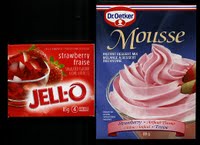 It was last week that Hilary brought Hitchcock’s 1954 film Dial M For Murder with Ray Milland and Grace Kelly. In spite of Grace Kelly the plot was much too convoluted and complex for Lauren to figure out and she became bored. “Papi,” Hilary told me, “If we are going to see a movie get one that Lauren can enjoy.” As difficult as that sounds, if one considers that not only do we want to please the 7 year-old girl but also ourselves, it was a simple task. I went to Videomatica to the Australian/New Zealand/British section and I found many films that would have satisfied us all. I picked the 2005 Masterpiece Theatre production My Family and Other Animals based on the autobiographical work of naturalist Gerald Durrell who happened to be the brother of Lawrence Durrell one of my favourite authors. The film was hilarious and it pleased us all. Lauren laughed a lot. Traditionally I like to cut roses for Saturday’s dinner table. The scan you see above is of the roses that made up the arrangement of today’s table. For me they represent the perfect end of a perfect day.
Stroke Improvement In Pearls
Friday, September 18, 2009
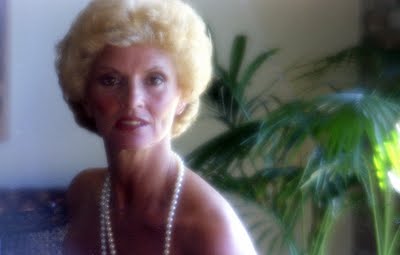 I left my mostly empty studio yesterday and I have been reflecting on how I got there. It really boils down to two women, Frances and Marlene Cohen. It was 1975 and I was trudging at my Tilden-Rent-A-Car job. The manager was a sexist pig before they were identified with the animal. I had to listen to his jokes or such questionable comments as wanting to sniff the bicycle seats ridden by beautiful girls (in 1975 girls were girls and not women). I could not sit down and read on virtually dead winter Sunday afternoons. If the manager caught me reading, instead of looking out of the window on Alberni Street to will clients to come in and rent cars he would make me wash windows or file dead files. In desperation I decided to take stroke improvement classes at the nearby YMCA. It was there that I met a beautiful French Canadian girl who asked me to photograph her as soon as she found out I wanted to be a photographer. I did not know she worked at Holt Renfrew. I did not know she put my colour pictures of her (alas I may have uncharacteristically thrown her pictures away) in the expensive frames of the gift department where she worked. It seems that Marlene Cohen (of Army & Navy fortune) came in one day and saw the pictures and noticed the likeness to the clerk that was attending her. In short order Marlene called me and I photographed her( picture above). She referred me to her sister-in-law Frances Cohen and I ended up taking pictures of the whole Cohen clan. Frances gave me her card to take to Vancouver Magazine’s Fashion Editor, Gabriel Levy. Levy looked at my portraits and told me I had no fashion sense but that I had possibilities as a portrait photographer. He gave me his card to take to Vancouver Magazine art director Rick Staehling. And that was the beginning of a beautiful relationship with a very good magazine and my career as a magazine photographer.
A Boom - From Simplicity To Complexity & Back Again
Thursday, September 17, 2009
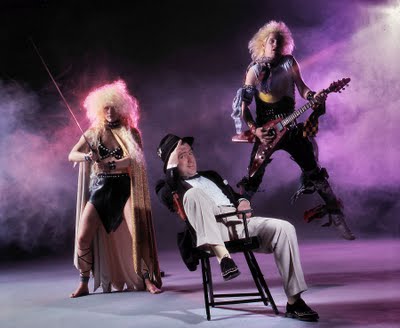
One of the last remaining items in my now almost empty studio is a large Manfrotto boom. It is a tall light stand from which one can suspend a light and point it downwards to get a 30/40s Hollywood look when using a precise and controlled light that has a limited dispersal. It was the boom that Marlene Dietrich demanded of her film directors once she liked how she looked in the publicity stills that George Hurrell took of her. I purchased the boom around 1983 from departing (for Toronto) photographer Brent Daniels. The boom has other uses. It makes a very good hair light that can be pointed exactly where you want it because there is a double hand crank system with which you can control the position of the light. Manfrotto booms are expensive. You need a large studio to use them. It would be difficult for me to sell it and get a good price for it. I will keep it.
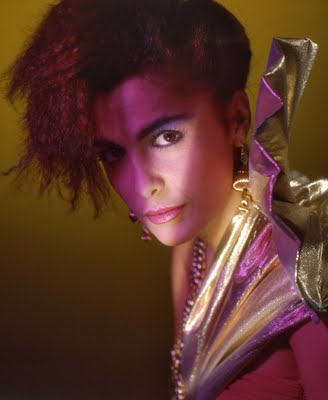
But the boom, all alone in my studio, made me think of my career as one of simplicity, complexity and back to simplicity. It was simplicity, a couple of 35mm cameras and a little flash unit that started me in business in 1976. By 1980 I had purchased some powerful (for then) Ascor studio flash units and a medium format Mamiya RB-67. Except for buying another couple of Mamiyas (one for parts and one as backup) my equipment is virtually the same today. I did buy a focusing spotlight to supplement my Ascor Fresnel spot. But my three softboxes (a small one, a medium one and a very large one) are 80s vintage. I stopped using umbrellas then. I have always preferred the ability of softboxes in giving me a more directional lighting than the wider spreading umbrellas.
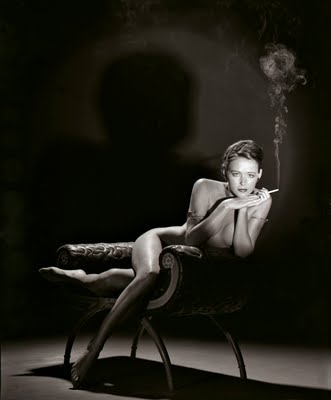
In today’s blog I want to demonstrate how the simplicity of my early years progressed to a complexity of multi lighting and the use of big sets in a big studio. When the magazine industry began to pull back in what they paid, their expectations also declined in what they wanted. The blog will finish with a photograph I took of cello player Cris Dirksen and soprano Melodi Mercredi that I took last week for this week’s Straight. I consider this a very emotionally satisfying photograph in which I used one 2 by 3 ft softbox in close proximity to a gray wall. Yet all the pictures you see here were taken by the same Mamiya and the same lenses.

It was in the photograph of belly dancer Sarita (one of the last that I took with an umbrella around 1982) where in retrospect I see what led me to last week’s double portrait. I took about 30 portraits of the beautiful Sarita in many poses. The one here is the only one I took just like that. It is all about an understanding and a moment of intimacy between photographer and subject that occurs when photographer and subject chat and get to know each other. There are no thoughts of virtuoso lighting in a large set using many lights to achieve a cutting edge look that proves the photographer knows how to use complex equipment.
It must have been around six years ago that I looked back at the Sarita picture and told myself that was the only kind of photography I wanted to do. Many who look at my pictures say I have a straight ahead and conservative style. I don’t mind the epithet even if they mean well. In fact I teach a popular course at Focal Point that is called Contemporary One Light Photography where I stress the use of that one 2x3 softbox and a gray wall.

As photographers close down their expensive studios (and this one is no different) I can see that even the simplicity of my “conservative” style is unusual in its scarcity. The one light (no softbox or umbrella) attached to an expensive digital Canon or Nikon is the style of the day. Marlene Dietrich would refuse to be photographed by this sort of light. If George Hurrell were around, he, too, would close down his studio!
My wife Rosemary urges me to buy a digital single lens reflex camera to become competitive. I am unable to explain that the camera is not the issue. The issue is the lighting and the approach one takes with one’s subjects. My sort of lighting and my approach is not viable now. I jokingly say it is obsolete. I only think that it is in dormancy and it will come back as soon as straight ahead lighting begins to bore.

Rosemary urges me to buy a digital single lens reflex camera so that I can “better” instruct my students at Focal Point and at Van Arts. I try to explain that I teach photography. I teach about my approach to portraiture, editorial and nude photography. I don’t teach how to use cameras. It is not about equipment as such. It is about a simplicity that becomes ever more complex and then it retreats and calms down to a satisfying simplicity. This is where I am now. But I will keep that boom. One never knows what time will bring!
Picture 1: Doug Bennett from the band Doug and the Slugs with Randy Rampage (DOA) up in the air. I cannot remember the name of the ecdysiast now. I took this photograph in 1985. I had no assistants even though I had to monitor two smoke machines. The light on the top right is the boom.
Picture 2: The lead singer of Moev (after Madeleine Morris left the band. Have a look at Morris under a boom in adjacent blog below.) I do not remember her name. I took this picture in 1985 and I would not be able to duplicate it if I tried. I did use a focusing spot light and many gels.
Picture 3: Kate Davitt, model, smoking. I took this in 1984. I used a boom spotlight pointing down and a second spotlight across her face. The boom spotlight acted as a back light so that the smoke can be seen. I took this in the huge studio I had on Hamilton Street in the not yet fashionable Yaletown.
Picture 4: Carla Temple, body builder. I used complex lighting and sets that I borrowed from the CBC. They had them in their Burnaby warhouse so I had to manhandle them on to a truck with the help of Vancouver Magazine writer Les Wiseman and editor Malcolm Parry. I took this in 1984. Art Director Chris Dahl, dispatched me with a, "Take some heroic pictures of her." Malcolm Parry added, "Make sure they wear very little."
Picture 5: Sarita. Perhaps 1983. I used an umbrella but this picture is what my style has become now even though I opt for a small 2x3 ft softbox. It was here that I temporarily (!) forgot about wanting to impress people with my complex lighting schemes that never seemed to reach the soul of my subjects.
Picture 6: I took this last week. On the left that's cello player Cris Derksen and on the right opera soprano Melodi Mercredi.
The styles above are all over the map but all taken with the same camera. A camera that has elements that are 35 years old. I exchange parts from the two other identical Mamiyas I have so that the one camera I use operates smoothly. I wonder if anybody will be using their modern cameras beyond a couple of years. The money these photographers save by not buying film is spent upgrading equipment and software that does not last beyond a couple of years. Will it ever get simple again?
Boom Shots
Lady Windermere under the boom
Karen Campbell under the boom
Crystal Pite under the boom
The Boom Shot - Madeleine Morris
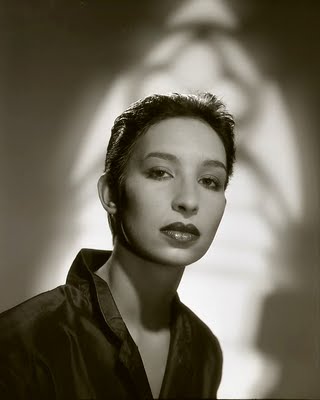
The Psychiatric Couch Finds A Home
Wednesday, September 16, 2009

Sometime in 1994 our Thursday noon lunches at the Railway Club came to an end. It had been going strong for some years. Mutual friends and friends of friends who were in the magazine business would meet to converse over lunch. There were writers, photographers, poets, urbanologists, cops, alternative scene punk musicians, literate cooks and ecdysiasts. There were lots of beautiful women. I remembered two of them (Katheryn and Andrea) today when I went to my studio with somber misgivings. I had mostly emptied my studio yesterday on my own and my son-in-law Bruce Stewart had volunteered to help me move out the larger stuff that might just fit in his old “liftback” Toyota.
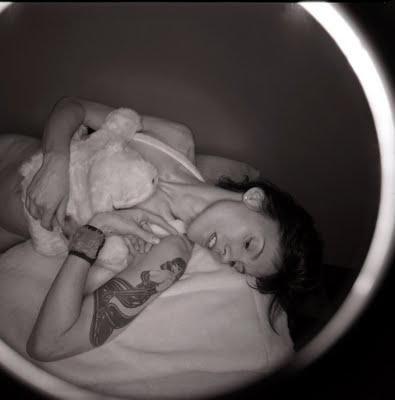
One of the beautiful women of the Railway club was Katheryn Petersen. I photographed her often in my studio for several years. It was around 1991 that she told me, “How do you expect women to undrape for you on a hard floor? You need a bed or divan of sorts.” My memory then simply vanishes (as to how I located the item of this blog) except that I know that a retiring psychiatrist sold me his couch for $100 and tacked $25 for its delivery. The couch is a classic mid-century psychiatric couch. It is firm (springs), beautifully upholstered and very heavy. By covering it with rumpled sheets it looked like a bed and I often used satin of several colours for special effects or for a Hollywood look of the 30s and 40s.
 What was I going to do with the couch? Would I have to rent a truck? Would I even want it in my house? Would someone want it? Or would I simply put it outside the studio in the hopes that someone would take it away. With the agony of leaving my studio almost behind me the couch became my principal preoccupation. I am happy to report that it had a happy ending.
BruceStewart, my son-in-law and I managed to take the couch down the three floors. Bruce had previously taken measurements and assured me it would fit in his car. He was right. On the way home (what was I going to do with it there? Where would I put it?) I told Bruce, “Why don’t we stop at Cook’s Upholstery on 16th and Oak and ask how much it would cost to re-upholster it?”

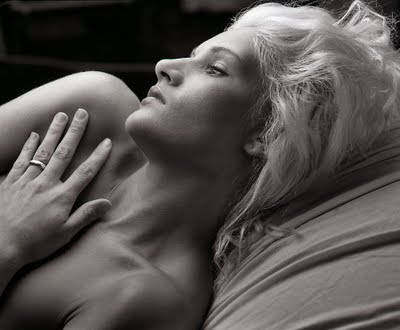
The couch has been in my studio all these years and the very strong material is showing wear. We talked to the most friendly Bob Arjun who looked at the couch hanging out of the Toyota and immediately told us, “Good coil springs, original material. It will need 8 yards of material.” “Bob, I know, the owner’s daughter Cathy, she is married to my friend Graham Walker.” To this Bob answered, “I have known Cathy since she was 4.” The labour estimate is $750 plus the 8 yards of material. The material can cost anywhere between $100 and $135 per yard. That is a lot of money so I will not have that couch repaired in the next while.

When we arrived at home, Rosemary directed Bruce and I and after moving some chairs here and there we found a place for the couch next to the piano. Bruce put a cat motif throw rug on it and it looked like it had been there for years. With the couch safely home with its good owner (that’s me!) closing that studio has not been as bad as I expected it to be.
As I thought about the happy ending for the day I pondered on three movies, two of which I never saw (The Red Violin, The Wedding Dress) and The Yellow Rolls Royce. The thread of these films is the story of the subsequent owners of the car, a wedding dress and the violin. Nobody has yet to make a film that follows the story of a psychiatric couch. Nobody will ever know the story of the many people who have lain on the couch, put their hands on their waist and then told their innermost secrets to the doctor. How many were cured?
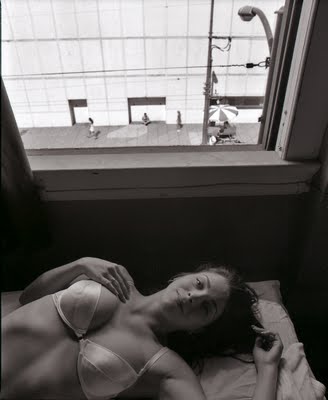
But I can give you a brief story in pictures of some of the beautiful women who have posed for me in that studio on Robson that is no more.
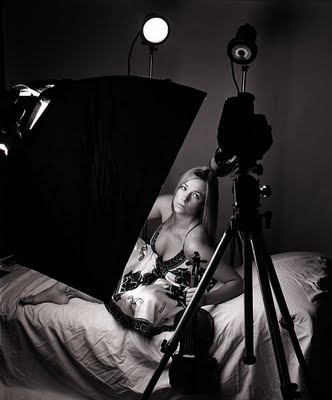
The first two photographs are Katheryn and the next three are Andrea. The following three are Leslie, the one showing my lights is with VSO violinist Robin Braun and the last little picture is of Tarren the fairest ecdysiast of them all.

One More Upmann On The Couch
 Even yesterday I knew I had made a mistake by not adding this picture I took of Leslie on my couch wearing my Puerto de Liverpool (a classy Mexico City department store) pinstripe suit. I recall that for effect (even if you didn't see them) she was also wearing a pair of my socks and my black brogues. Leslie is smoking an H.Upmann cigar. None Nicer
Posthumous Advice From Fred Schiffer
Tuesday, September 15, 2009
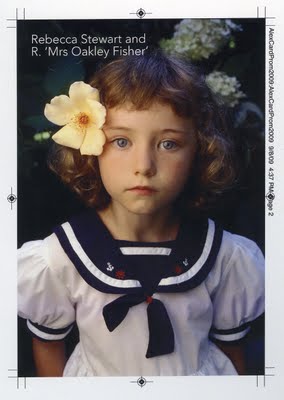 In 1974 Rosemary told me that the future didn’t look too good in our Mexico City. She added that she saw it as a difficult home for our daughters Alexandra and Hilary. She suggested we move to Canada. We put our house for sale and we quit our teaching jobs. We suffered a shock when we could not sell our house. I decided to take portraits of the wealthy Mexicans who lived in the Pedregal area near the University. Business was so good, in spite of my primitive equipment and no lighting. My neighbourhood friends urged me to stay and take the house out of the market. “Alex you are doing so well, change your mind.” We didn’t and we drove to Vancouver in our VW Beettle. Since I was not able to find work as a photographer immediately (I had no portfolio) I worked for Tilden Rent-A-Car for a year. Meanwhile I would visit Fred Schiffer and his wife Olive at their beautiful photographic studio underneath the Hudson’s Bay skywalk on Seymour Street. I would feast my eyes on the perfect (and very large) framed portraits of Supreme Court justices and other famous people of Vancouver and Canada. Fred and Olive would tell me that I needed patience and that work would eventually come. They were right in the end and I left my job at Tilden and started work for the CBC and for Vancouver Magazine.  Around the end of the 80s or perhaps in the beginning of the 90s Fred saw the writing on the wall and closed his studio. He must have been around 65 (two years younger than I am now). He purchased portable flash equipment and began offering his services to the very wealthy families of our City. He prospered while photographers with studios were struggling. Before the digital revolution finally hit Vancouver and changed everything, Fred was the most expensive wedding photographer in town. And he was in demand. Today I went to my studio and took it down. I had given notice so I knew I had to be out by September 30. But still I had that little hope that something would change. Just like a home is not a home until there are pictures hanging on the wall my studio was no longer one when I removed my pictures including one of my favourites of Evelyn Hart. Once the pictures were down the rest was easy. After 17 years in that studio I had collected a lot of junk. I got rid of it including 25 assorted phone books I used to control the height of my subjects. I arrive home sweaty and tired but somehow almost relieved and at peace. Could it be that my new leaf is a new chapter or will it be, ominously an afterword? Time will tell. My last kick at the can is a set of four postcards that were designed by my good friend and designer Ian Bateson of Baseline Type & Graphics. These four cards (including the one you see here) feature Arthur Erickson, a Hosta lady and portrait of Rebecca and Lauren. The cards are being printed by Metropolitan Fine Printers. I made a trade with owner George Kallas who is using my pictures of him (which I took for a Toronto based graphics to promote his business. George is a perfectionist so he told me, "If you want me to print your postcards you had better go to your friend Grant Simmons at DISC to have your transparencies drum-scanned. 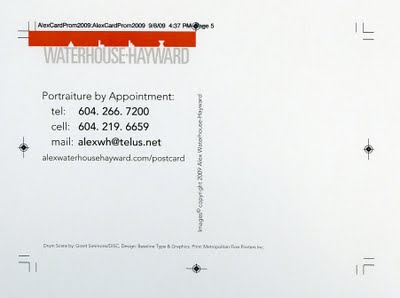 The cards will have an address alexwaterhousehayward.com/postcard that will directly link to a portrait portal within my web page. The advice and suggestion to this came from Ray Mah of Leap Creative. It is he who designed my identity (see the obverse side of the postcard) 30 years ago. His design has remained fresh all these years. With help from Grant Simmons, Ian Bateson, George Kallas, Ray Mah and some posthumous advice from Fred Schiffer I just might have another career in front of me.
Finding Stuff
Monday, September 14, 2009

I started shooting as a magazine photographer around 1976 and until the late 90s when magazines began a decline in quantity, quality and editorial space I guarded my sources for finding stuff jealously. Before the advent of Google (have we forgotten about Altavista?) finding stuff in Vancouver was not so easy. Yet I remember that in the early 80s a band called Popular Front (they labeled themselves to be mercenary punks of the avant-garde ) hired me to take their photographs and they asked me if I could find a military halftrack. It took me less than an hour to find one (it was in the pre Granville Island, Granville Island) that had a .50 caliber machine gun mounted on the roof. Alas I have misfiled Popular Front so I cannot show the neat picture here. But I can show one of a man that is still in business since I first met him at the end of the 70s. He had then, as now, a business called Lever Arms Service. Alan Lever was a buddy of the then editor of Vancouver Magazine, Mac Parry. Every now and then I needed a gun for a prop so I went to Lever to borrow it. As soon as gun laws got stickier I had to take the pictures at Lever Arms since transporting guns without a license was against the law.
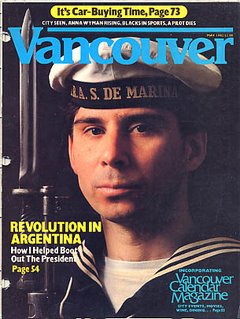
That was the case in 1982 during the Falklands War. Mac had asked me to write about my experience in the Argentine Navy during the mid 60s. He insisted in taking my photograph for the cover dressed in an Argentine Navy uniform. All I had kept was the band that went around my navy cap, but not the cap. I had to find everything else. The blue uniform came from a collector who had British Navy uniforms. The navy collar and the cap came from a collector of German U-boat uniforms. The Mauser rifle and the Israeli bayonet, that fit just right, came courtesy of Alan Lever. Mac took the picture (with my camera) at Lever Arms.
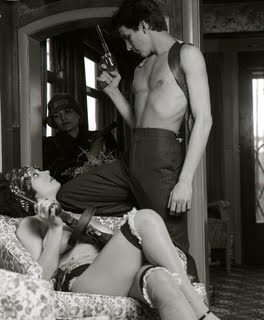
The tommy gun with Alan Lever had been fixed to be legal. In the picture you can see that is has a different cartridge holder. The usual round one can be seen in the picture, left. I took it for a gay tabloid of the 80s called Bi-Line. I shot a series of pictures that made a narrative. This is the safest one that I can show. The location was an antique railroad parlour car that was owned by Harry Atterton. On paper he was the owner of the Sooke Railway Company. I believe the parlour car was the only rolling stock he owned. Atterton is now retired and lives in his restored castle in France.
Lever Arms
Harry Atterton's Castle in France
Addendum: Popular Front found!
An Original
Sunday, September 13, 2009
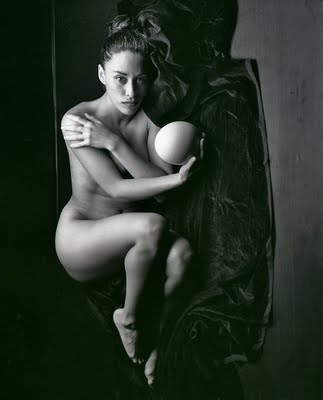
It was on Saturday that I was finally able to take Rebecca and Lauren to see the show Vermeer, Rembrandt and the Golden Age of Dutch Art Masterpieces from the Rijksmuseum at the Vancouver Art Gallery.
Rebecca kept asking me, “Is that an original?” I was surprised as Rebecca is a veteran (age 6) of the National Gallery in Washington, DC. There I showed her my favourite American paintings including Winslow Homer’s Left & Right (see, below, centre)and several works by Goya including his portrait of Wellington which at the time was across from David's huge portrait of Napoleon.
Something has transpired in Rebecca’s life (education?) that she now questions the authenticity of what she sees. The first thing that comes to mind is the label on some orange juice containers at Safeway that say, “100% Pure Orange Juice”. Underneath in smaller it says “Reconstituted.”
If I can persue this staccato train of thought, the next thing that comes to mind is a funeral I attended in Buenos Aires when I was 8. My next door neighbour’s son, in the middle of a rainy night, had not seen the barrier (it was down) in a street level railroad crossing. He crashed his Vespa into the train. Our neighbours had the audacity to have an open casket velorio. I snuck in and saw the face in small sections, somehow stitched together, very much like a haphazard jigsaw puzzle. It was the first dead body I ever saw. That’s what comes to mind when I think of reconstituted.

Somehow the image of da Vinci’s La Gioconda when I see it on my monitor, is a reconstituted (all those zeros and ones, all those pixels, all that interpolation) image of the real thing I saw in 1985 at the Louvre.
In at least two of William Gibson’s early novels a boy and his father go to a shopping mall and the boy makes the comment, “Dad look at that stuffed horse!” It seems that Gibson was already thinking of a future were the idea of a horse would be a stuffed one in a shopping mall.
In 1986 when we moved to our present Kerrisdale home on Athlone Street my knowledge of gardening was small. There was a plant on the side of the house (beneath the guest bathroom) that looked like a weed. I wasn’t sure so I let it grow a season. It was sometime in August of 1987 that I saw a swarm of Monarch butterflies while using the bathroom. They were hundreds of them on the purple/blue flowers of the erstwhile weed. The weed was a Buddleia davidii or Butterfly Bush. The swarms disappeared by the end of the mid 90s. I may have seen one or two Monarchs in my garden in the last couple of years.
Thinking back about the boy and his father and the spotting of that horse I have noticed that tourists and gallery goers (when they are permitted) take digital photographs of paintings and sculptures. For years museums allowed cameras without flash and without a tripod into galleries. They figured that very fast b+w film would be useless in copying the nuances of a work of art. The tripod somehow was seen as the mark of a professional so a prohibition against the use of one gave the museum a broad comfort zone that things were all well. All this ended with the ubiquity of the little digital camera held at arm’s length. Museums (except in places like Mexico or Argentina and our very own VAG) gave up enforcing the law.
Probably one of the most photographed objects on earth is the Louvre’s La Gioconda. What is it that makes the tourist photograph the original and reconstitute it in photographic pixels? They think that the “capturing” of the image of the real thing is equivalent to proving that the real thing is the real thing. They are no different from my granddaughter wanting to know if the painting is an original or the boy in the shopping mall wanting to know if the stuffed animal is, indeed, a real horse.
For better (better in my opinion) or for worse my Rebecca is the last of a generation that in its innocence (gently prodded by her grandfather) was lured to sitting next to the glass barrier at the Vancouver Aquarium. Rebecca and I were thoroughly splashed and soaked by the great tail splat of a killer whale. The killer whales are gone and few children (at the expense of the captured and penned animal many will assert) will ever experience that thrill.

It was the thrill that Rebecca, Rosemary and I had in Mexico’s largest zoo (a very large one with great areas for animals to roam) when we saw a couple of giraffes saunter after each other around mesmerized African ostriches. The giraffes looked like stretched horses running underwater. It was a magical moment for the three of us.
This brings me to being 8 or 9, and getting on a horse on the Argentine Pampa. I would gallop through the tall grass in search of that sudden moment when an ostrich (the South American variety called a ñandú) would spring up and run. I would point the horse in pursuit. The ñandú would do this as I approached their nests with the big eggs. The “dumb” bird simply wanted me to go as far as possible from the nest.
And yes the egg in the picture is an original if hollow. I look forward to showing Rebecca more originals.
The Real Thing
|




































